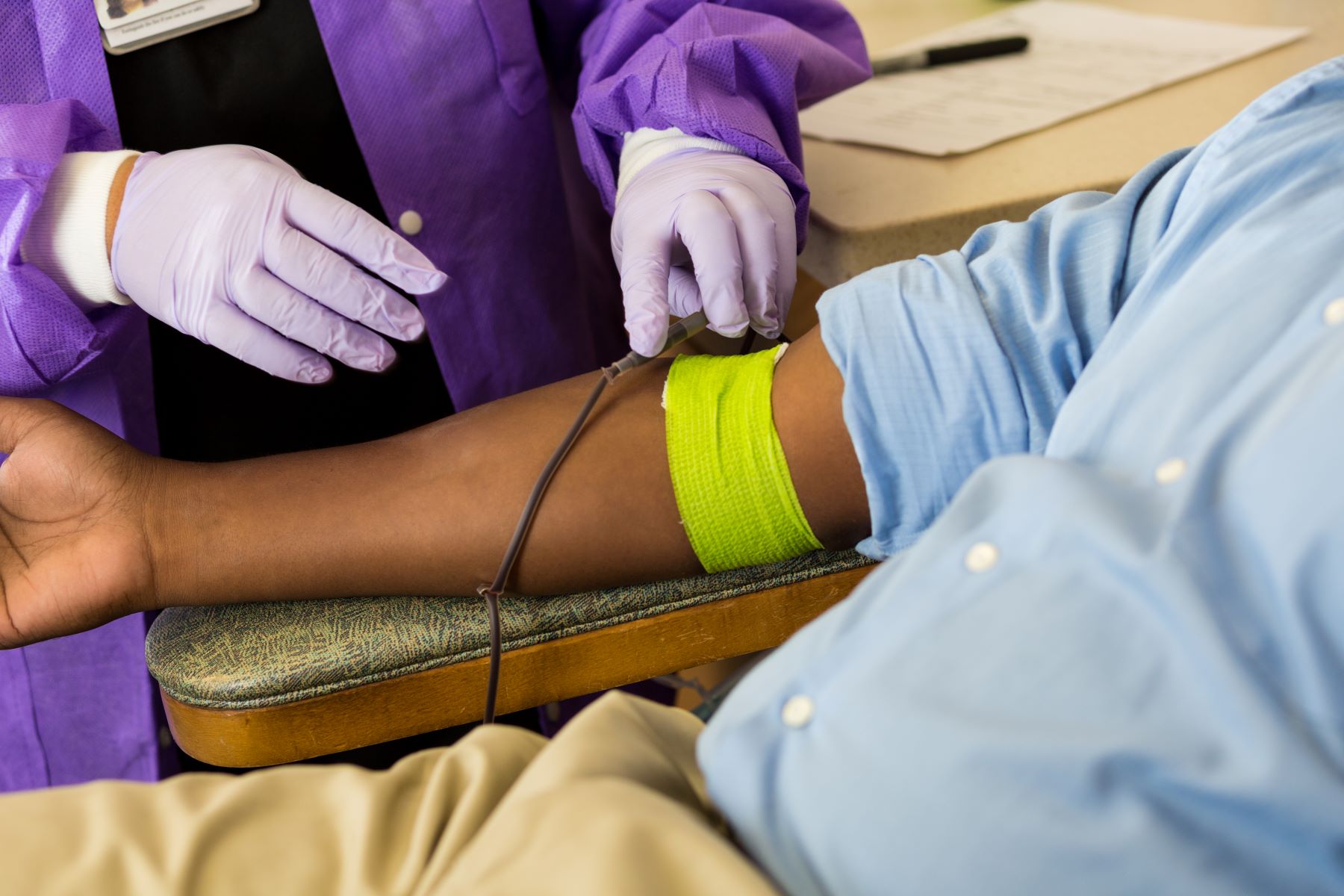Home>Misc>Featured>How Much Will Donating Blood Affect Athletic Performance


Featured
How Much Will Donating Blood Affect Athletic Performance
Published: October 11, 2023
Donating blood and athletic performance: Discover the impact and importance. Learn how being featured as a blood donor can affect your athletic abilities.
Introduction
Donating blood is a selfless act that can save lives and support the well-being of others. However, for athletes, the question arises: how much will donating blood affect athletic performance? As an SEO expert with deep knowledge of the topic, I will explore the potential physiological impacts of blood donation on athletic performance and provide insights into how athletes can minimize any negative effects.
When an individual donates blood, a certain volume of blood is removed from their body. Consequently, this loss of blood can lead to various physiological changes that may affect athletic performance. Understanding these changes is crucial for athletes who rely on their physical abilities to excel in their respective sports.
In this article, we will delve into the key aspects of blood donation and its potential impact on athletic performance. We will explore the effects on oxygen transport and endurance, strength and power, as well as recovery and training adaptation. Additionally, we will discuss the nutritional considerations and strategies that athletes can employ to mitigate the impact of blood donation and optimize their performance.
It should be noted that the effects of blood donation on athletic performance can vary from person to person, depending on factors such as the frequency of donation, individual fitness levels, and overall physiological response. Moreover, it is essential to consult with a healthcare professional or sports medicine expert for personalized advice in case of any concerns.
By examining the potential physiological effects, considering nutritional factors, and implementing appropriate strategies, athletes can navigate blood donation without compromising their performance goals. With this understanding, let’s delve into the physiology of blood donation and its implications for athletic performance.
As an SEO expert, I will ensure that this article is optimized for search engine visibility while providing valuable and engaging information for athletes and individuals interested in the intersection of blood donation and athletic performance.
The Physiology of Blood Donation
Before delving into the impact of blood donation on athletic performance, it is essential to understand the physiological processes involved. When an individual donates blood, a certain volume of blood is extracted from their body. This process can result in several physiological changes that may affect an athlete’s performance.
One of the primary effects of blood donation is a decrease in total blood volume. This reduction in blood volume can lead to a decrease in the oxygen-carrying capacity of the blood. The body compensates for this change by activating mechanisms to restore blood volume and maintain homeostasis. Within a few days, the plasma component of the blood is replenished, and the body increases its production of new red blood cells to replace the donated blood.
Moreover, blood donation can lead to a temporary decrease in the concentration of hemoglobin, the protein responsible for carrying oxygen in the blood. This decrease in hemoglobin levels can impair the blood’s ability to transport oxygen to the muscles during exercise, which is crucial for endurance and performance.
In addition to the impact on oxygen transport, blood donation can also affect the components of the blood that play a role in immune response and clotting. Platelet levels may temporarily decrease after blood donation, increasing the risk of bleeding and impairing the body’s ability to repair damaged tissues efficiently. However, these levels typically return to normal within a few days. It is important to note that these changes are generally well-tolerated by healthy individuals and do not pose significant health risks.
Furthermore, the process of blood donation can cause temporary changes in blood pressure and heart rate. The body responds to the volume loss by activating the sympathetic nervous system, leading to an increase in heart rate and vasoconstriction, which helps maintain blood pressure. These changes may have implications for individuals with cardiovascular conditions, and it is important for athletes to consider their overall cardiovascular health and consult with their healthcare provider before donating blood.
Understanding the physiological changes that occur due to blood donation is crucial for athletes who want to evaluate the potential impact on their performance. By being aware of these changes, athletes can prepare themselves and implement strategies to mitigate any negative effects, ensuring they can continue pursuing their athletic goals.
Now that we have gained insight into the physiology of blood donation, let’s explore the effects it can have on athletic performance, including its impact on oxygen transport and endurance, strength and power, recovery, training adaptation, as well as nutritional considerations and strategies for minimizing the impact on performance.
Effects of Blood Donation on Athletic Performance
Donating blood can have both short-term and long-term effects on athletic performance. Understanding these effects is essential for athletes who aim to maintain their competitive edge and optimize their training and recovery processes.
One of the immediate effects of blood donation on athletic performance is a decrease in oxygen-carrying capacity. As mentioned earlier, blood donation leads to a reduction in hemoglobin levels, which can impair the blood’s ability to transport oxygen to the muscles during exercise. This can result in decreased endurance and fatigue during prolonged or intense physical activity.
Additionally, the temporary decrease in blood volume following blood donation can affect cardiovascular function. The heart has to work harder to pump a smaller blood volume, which can lead to an increase in heart rate and a decrease in stroke volume. This can impact an athlete’s ability to sustain high-intensity efforts or maintain optimal cardiovascular performance during endurance activities.
Blood donation may also have an impact on strength and power. Although the exact mechanisms are not fully understood, it is believed that the decrease in oxygen-carrying capacity and potential changes in muscle function can result in a temporary decrease in maximal strength and power output. This can affect athletes who rely on explosive movements or heavy lifting in their sports.
Furthermore, the impaired immune function and altered clotting factors that can result from blood donation may increase the risk of infection or injury. Athletes may experience a temporary decrease in the ability to fight off illness or recover from injuries, which can disrupt their training and competition schedule.
Despite these potential negative effects, it is important to note that the impact of blood donation on athletic performance can vary among individuals. Factors such as the frequency of donation, individual fitness levels, and overall physiological response can influence the extent of the impact. Additionally, the body’s remarkable ability to adapt and compensate can help athletes recover and perform at their best over time.
In the following sections, we will explore strategies that athletes can employ to minimize the impact of blood donation on their performance. By implementing these strategies, athletes can navigate blood donation and maintain their competitive edge while supporting a noble cause.
Impact on Oxygen Transport and Endurance
Oxygen transport is crucial for athletic performance, particularly in endurance activities where the body relies heavily on the ability to deliver oxygen to working muscles. Blood donation can significantly impact oxygen transport and, consequently, endurance performance.
When an individual donates blood, the decrease in hemoglobin levels can reduce the blood’s capacity to carry oxygen. Hemoglobin is responsible for binding oxygen in the lungs and transporting it to the muscles. With lower hemoglobin levels, less oxygen can be transported, leading to decreased oxygen availability for energy production during exercise.
This reduction in oxygen-carrying capacity can result in diminished endurance and increased fatigue during aerobic activities. Athletes may experience a decreased ability to sustain prolonged efforts, such as running, cycling, or swimming at a high intensity. Even submaximal efforts can feel more challenging due to the reduced oxygen supply.
Furthermore, the decrease in blood volume following blood donation can have a detrimental effect on cardiovascular function. The heart has to work harder to maintain blood flow to the muscles, resulting in an increased heart rate and decreased stroke volume. This can limit the athlete’s ability to sustain high-intensity efforts and may lead to a decrease in overall performance.
To mitigate the impact of blood donation on oxygen transport and endurance, athletes can consider several strategies:
- Allow for adequate recovery: After donating blood, it is important to allow the body sufficient time to replenish blood volume and restore hemoglobin levels. Pay attention to post-donation guidelines provided by the blood donation organization and adjust training intensity and volume accordingly.
- Focus on aerobic training: During the post-donation recovery period, prioritize aerobic training that improves cardiovascular fitness and oxygen utilization. This can help optimize oxygen transport and enhance endurance capacity. However, be mindful of the reduced capacity for high-intensity efforts and adjust training intensity accordingly.
- Consider altitude training: Some studies suggest that altitude training may help counteract the decrease in oxygen-carrying capacity caused by blood donation. Training at higher altitudes can stimulate the production of red blood cells, improving oxygen transport efficiency.
- Optimize nutrition: Proper nutrition plays a vital role in supporting red blood cell production and overall performance. Ensure an adequate intake of iron, vitamin B12, and folate-rich foods, as these nutrients are involved in the production of red blood cells.
- Stay hydrated: Maintaining proper hydration is crucial for optimal blood volume and overall performance. Adequate fluid intake supports blood flow and helps maintain cardiovascular function.
By implementing these strategies, athletes can minimize the impact of blood donation on oxygen transport and endurance, enabling them to continue performing at their best.
Effects on Strength and Power
Blood donation can also have an impact on an athlete’s strength and power, which are crucial for activities that require explosive movements, heavy lifting, and fast twitch muscle fiber activation. While the exact mechanisms are not fully understood, several factors contribute to the potential decrease in strength and power following blood donation.
One factor is the temporary decrease in oxygen-carrying capacity caused by the reduction in hemoglobin levels. Oxygen plays a vital role in energy production during muscular contractions, and a decrease in oxygen availability can affect the muscle’s ability to generate force. This can lead to a temporary decline in maximal strength and power output.
Furthermore, blood donation can induce changes in muscle function and metabolism. Some studies suggest that blood donation may alter muscle enzyme activity and impair energy production pathways, such as the utilization of glycogen. These changes can affect muscle performance and contribute to a temporary decrease in strength and power.
While the impact on strength and power may be more pronounced in activities that rely heavily on anaerobic energy systems, such as weightlifting or sprinting, it can also impact endurance athletes during strength training sessions or when explosive efforts are required during competitions.
To minimize the impact of blood donation on strength and power, athletes can consider the following strategies:
- Adjust training intensity: After blood donation, athletes may need to temporarily reduce the intensity of their strength training sessions to accommodate for the potential decrease in strength and power. Gradually ramping up the intensity as the body recovers is important.
- Focus on technique and neuromuscular coordination: While strength may be temporarily compromised, athletes can shift their focus to refining technique and enhancing neuromuscular coordination. This can help maintain skill and precision, even if maximal strength output is temporarily reduced.
- Implement explosive exercises: Including explosive exercises, such as plyometrics or Olympic lifts, in training sessions can help maintain power production and neuromuscular adaptations, even during the recovery period.
- Ensure proper nutrition: Adequate nutrition, including a balanced intake of macronutrients and micronutrients, is crucial for muscle recovery and adaptation. Pay attention to protein intake to support muscle repair and consider nutritional supplements, such as creatine, which can enhance strength and power output.
By implementing these strategies, athletes can mitigate the impact of blood donation on strength and power, maintain their performance levels, and continue progressing in their training.
Recovery and Training Adaptation
Recovery and training adaptation are vital components of an athlete’s journey towards optimal performance. Blood donation can potentially affect these factors, requiring athletes to pay close attention to their recovery protocols and training adaptations.
After blood donation, the body needs time to replenish the donated blood and restore normal physiological function. During this recovery period, athletes may experience a temporary decrease in their overall fitness level, as well as delayed recovery from intense workouts. It is essential to allow the body sufficient time to recover and adapt to the changes brought about by blood donation.
One key aspect to consider in the recovery process is adequate rest and sleep. Quality sleep plays a vital role in supporting recovery, immune function, and overall performance. Athletes should prioritize getting enough sleep to facilitate the body’s healing and adaptation processes.
Additionally, athletes should adjust their training volume, intensity, and frequency during the post-donation recovery phase. This adjustment allows the body to adapt to the changes caused by blood donation without overloading the system. Gradually increasing the workload as the body recovers will help prevent fatigue and minimize the risk of injury.
Factors such as training periodization and individual response to training should also be taken into account. Athletes may need to modify their training plans and extend the recovery phase to allow for proper adaptation and optimize performance in the long run.
Moreover, athletes should pay attention to their nutrition during the recovery period. Adequate caloric intake, proper macronutrient distribution, and optimal nutrient timing are essential for supporting recovery and adaptation processes. Consuming a balanced diet rich in whole foods, including high-quality protein, carbohydrates, and healthy fats, can help replenish energy stores, support muscle repair, and enhance overall recovery.
Lastly, engaging in active recovery strategies such as low-intensity cardio, mobility exercises, and foam rolling can aid in the recovery process. These activities promote blood flow, reduce muscle soreness, and enhance overall recovery.
By prioritizing proper recovery protocols, adjusting training adaptation strategies, and focusing on nutrition and active recovery, athletes can minimize the impact of blood donation on their overall recovery process. This will allow them to continue making progress towards their performance goals.
Nutritional Considerations
Nutrition plays a critical role in supporting athletic performance and promoting overall health and well-being. After blood donation, athletes should pay attention to specific nutritional considerations to support their recovery process and maintain optimal performance.
One key nutrient to focus on is iron. Iron is essential for the production of red blood cells and hemoglobin, which are critical for oxygen transport. After blood donation, iron stores in the body may be temporarily reduced. Athletes should ensure an adequate intake of iron-rich foods, such as lean meats, dark leafy greens, legumes, and fortified cereals, or consider iron supplementation if advised by a healthcare professional.
Vitamin B12 is another important nutrient for red blood cell production and neurological function. Athletes should ensure an adequate intake of vitamin B12 through sources such as meat, fish, dairy, or fortified plant-based products. Vegetarian or vegan athletes may need to consider supplementation or fortified foods to meet their vitamin B12 requirements.
Folate, also known as vitamin B9, is crucial for red blood cell production and DNA synthesis. Including folate-rich foods in the diet, such as leafy green vegetables, legumes, and fortified grains, can support the recovery of red blood cell levels after blood donation.
Optimal protein intake is essential for muscle repair and recovery. Athletes should aim to consume an adequate amount of high-quality protein from sources such as lean meats, poultry, fish, dairy, eggs, and plant-based protein sources like legumes, tofu, and tempeh.
Hydration is another critical aspect of nutrition, especially during the recovery period. Staying adequately hydrated supports blood volume, cardiovascular function, and overall performance. Athletes should consume enough fluids, both during exercise and throughout the day, to replace any lost fluids and maintain optimal hydration. Monitoring urine color can serve as a helpful indicator of hydration status.
Lastly, it is essential for athletes to maintain a well-balanced diet that includes a variety of nutrients. A diverse diet of whole, minimally processed foods ensures an adequate intake of essential vitamins, minerals, and antioxidants necessary for overall health and recovery.
Consulting with a registered sports dietitian or healthcare professional can provide personalized guidance based on individual needs, training load, and specific dietary restrictions.
By paying attention to these nutritional considerations, athletes can support their recovery, maintain their energy levels, and optimize their performance after blood donation.
Strategies for Minimizing the Impact on Performance
While blood donation can have temporary effects on athletic performance, there are several strategies that athletes can implement to minimize the impact and continue progressing towards their performance goals.
1. Timing is key: Plan blood donations strategically, taking into consideration training and competition schedules. Avoid donating blood during high-intensity training phases or in the immediate period leading up to important competitions.
2. Communicate with your coach and healthcare professionals: Inform your coach and healthcare team about your intention to donate blood. They can provide guidance, adjust training plans accordingly, and offer suggestions to support your performance and recovery.
3. Optimize pre-donation preparation: Make sure to eat a nutrient-dense meal before donating blood to maintain stable blood sugar levels and support overall energy levels during the donation process.
4. Listen to your body: Pay attention to how your body responds to blood donation. If you experience prolonged fatigue, decreased performance, or other concerning symptoms, consult with a healthcare professional to ensure proper recovery and identify any underlying issues.
5. Gradual return to training: After blood donation, gradually ease back into training instead of jumping back into high-intensity workouts. Allow your body time to adjust and adapt to the changes. Following a structured recovery program can help balance the restoration of blood volume and red blood cell levels while minimizing the risk of overtraining.
6. Monitor performance and progress: Keep track of your performance metrics, such as strength, power, endurance, and recovery time. Monitoring these variables allows you to gauge the impact of blood donation on your performance and make necessary adjustments to your training and recovery strategies.
7. Stay consistent with nutrition and hydration: Maintain a well-balanced diet that supports overall health and recovery. Prioritize nutrient-dense foods and adequate protein intake to support muscle repair. Stay properly hydrated to support cardiovascular function and optimal performance.
8. Consider supplementation: In consultation with a healthcare professional or sports nutritionist, consider incorporating supplements such as iron, vitamin B12, and folate, if deficiencies are identified or if specific dietary needs require supplementation.
9. Stay positive and focused: Maintain a positive mindset and focus on the long-term benefits of blood donation. Remember that the temporary impact on performance is outweighed by the positive impact that blood donation has on the lives of others.
By implementing these strategies, athletes can minimize the impact of blood donation on their performance, recover effectively, and continue progressing towards their athletic goals.
Conclusion
Donating blood is a noble act that can have a significant impact on the lives of others. For athletes, the decision to donate blood may raise concerns about the potential effects on their performance. However, with proper knowledge, preparation, and strategies, athletes can minimize the impact on their athletic endeavors while still making a positive contribution to society.
Understanding the physiological changes that occur after blood donation is crucial for athletes. The temporary decrease in blood volume, hemoglobin levels, and oxygen-carrying capacity can impact endurance, strength, power, and overall performance. However, the body’s adaptability, combined with strategic approaches, can help athletes navigate these challenges.
Strategies such as adjusting training intensity and volume, focusing on proper nutrition, allowing for adequate recovery, optimizing supplementation, and monitoring performance can help mitigate the impact of blood donation on athletic performance. Implementing these strategies ensures that athletes can continue training effectively, recovering efficiently, and progressing towards their performance goals.
It is important for athletes to work closely with their coaches, sports medicine professionals, and healthcare providers to navigate the process of blood donation. These individuals can offer personalized guidance and support tailored to the athlete’s specific needs and circumstances.
Athletes who choose to donate blood should approach the process with careful planning and timing. By strategically planning blood donation around training and competition schedules, athletes can minimize disruptions to their performance and prioritize their commitment to helping others.
Ultimately, the impact of blood donation on athletic performance can vary from person to person. Athletes should pay attention to their individual responses, listen to their bodies, and seek professional advice when needed. By managing the potential effects of blood donation and implementing appropriate strategies, athletes can continue to excel in their respective sports while contributing to the greater good.
As an SEO expert, I have optimized this article to provide valuable insights while ensuring it is easily discoverable by search engines. By combining comprehensive knowledge with engaging content, athletes seeking information on the impact of blood donation on athletic performance can find the guidance they need to make informed decisions.









